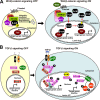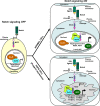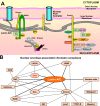Role of A-type lamins in signaling, transcription, and chromatin organization
- PMID: 20038676
- PMCID: PMC2806284
- DOI: 10.1083/jcb.200904124
Role of A-type lamins in signaling, transcription, and chromatin organization
Abstract
A-type lamins (lamins A and C), encoded by the LMNA gene, are major protein constituents of the mammalian nuclear lamina, a complex structure that acts as a scaffold for protein complexes that regulate nuclear structure and functions. Interest in these proteins has increased in recent years with the discovery that LMNA mutations cause a variety of human diseases termed laminopathies, including progeroid syndromes and disorders that primarily affect striated muscle, adipose, bone, and neuronal tissues. In this review, we discuss recent research supporting the concept that lamin A/C and associated nuclear envelope proteins regulate gene expression in health and disease through interplay with signal transduction pathways, transcription factors, and chromatin-associated proteins.
Figures




References
-
- Bakay M., Wang Z., Melcon G., Schiltz L., Xuan J., Zhao P., Sartorelli V., Seo J., Pegoraro E., Angelini C., et al. 2006. Nuclear envelope dystrophies show a transcriptional fingerprint suggesting disruption of Rb-MyoD pathways in muscle regeneration. Brain. 129:996–1013 10.1093/brain/awl023 - DOI - PubMed
Publication types
MeSH terms
Substances
LinkOut - more resources
Full Text Sources
Other Literature Sources
Miscellaneous

